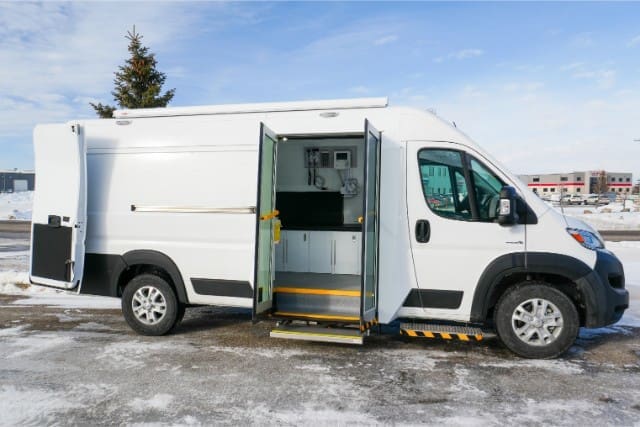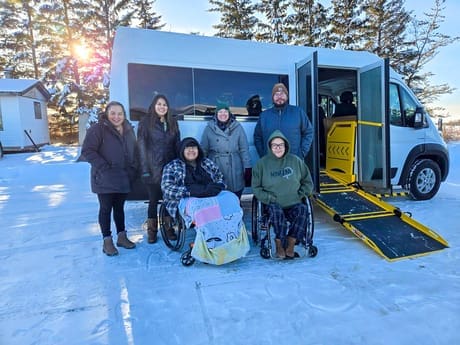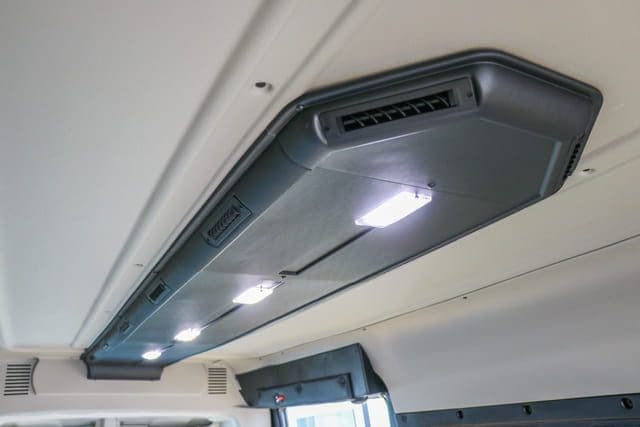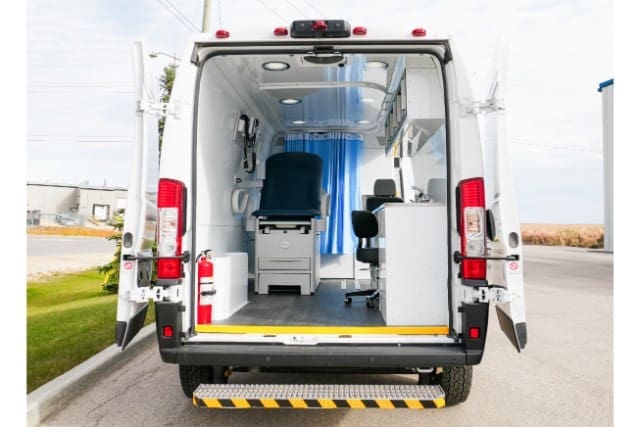Does your community struggle to access safe and reliable healthcare or transportation, or are you having BCR challenges?
Many First Nations communities face big challenges when it comes to getting wheelchair-accessible or mobile medical vans. One of those challenges is that around 40% of First Nations people live in remote areas. If you’re in this category, you might feel stuck, trying to balance your community’s needs with limited budgets, remote locations, or tricky paperwork like Band Council Resolutions (BCRs).
These barriers can leave people in your community without the care or transportation they need, which can be stressful when you want to make a difference.
What happens if nothing changes?
- Health suffers: People can’t get to medical appointments or treatments.
- Stress grows: You feel the pressure of not being able to meet your community’s needs.
- Opportunities are missed: Access to care and independence are harder to achieve.
Finding the right vehicle can close this gap. Imagine having a reliable van that brings elders to hospitals or brings healthcare right to your community. This could mean:
- Better health for everyone.
- Easier access to important services.
- Less stress for you and your team.
At MoveMobility, we’ve spent over 20 years helping communities like yours. We build wheelchair accessible and mobile medical vans that save lives and break down barriers. Our certifications with Ford QVM and Stellantis QPro show we meet high safety and quality standards. While we know we’re not the only option out there, we’ve worked with First Nations communities like yours and Keewatinohk Inniniw Minoayawin across Canada and are here to help you.
What you’ll learn in this article:
- How leasing a van can benefit your community.
- What challenges come with BCRs—and how to navigate them.
What does the leasing process for First Nations communities involve?
Leasing a wheelchair accessible or medical van can feel complicated, but the process is straightforward when you have the right support.
Here’s a snapshot of how it works:
1. Understanding your needs:
We start by talking with you to learn about your community’s needs. This helps us figure out the best van solution. Once we understand what you need, we’ll provide a detailed proposal that includes all costs.
2. Exploring leasing options:
If you’re interested in leasing, we’ll connect you with one of our trusted commercial leasing partners. These experts have experience working with First Nations communities and will review the proposal with you.
3. Discussing lease details:
The leasing partner will go over options like:
- Down payment amounts.
- Length of the lease term.
- Residual value (the van’s value at the end of the lease).
After that, they’ll create a formal lease proposal for you to consider.
4. Making your choice:
You can decide to move forward with the lease or return to the original proposal to purchase the van outright. Take a look at the videos below to learn more about the cost of wheelchair and mobile medical vans.
What are the benefits of leasing for First Nations communities facing challenges?
Leasing a wheelchair accessible or medical van offers flexibility and practical benefits for First Nations communities, especially when budgets or funding are limited.
Here’s why leasing might be the perfect fit:
1. No big upfront costs:
Leasing eliminates the need for a large initial payment. This is helpful when government funding doesn’t cover capital purchases or when cash flow is tight.
2. Fixed, predictable payments:
With a lease, your community gets a fixed cost structure. This means you’ll know exactly what to budget every month without worrying about surprise expenses.
3. Faster access to vehicles:
Leasing allows you to get the van you need sooner. This can be a game-changer if your timeline depends on:
- Seasonal access: Tying delivery to summer sealift or winter ice road windows.
- Program launches: Starting a new program without waiting for full capital funding.
4. Flexibility at the end of the lease:
When the lease is over, you have options:
- Return the vehicle and lease a new one.
- Buy the vehicle at a reduced price.
- Sell the vehicle for a profit after purchasing it at the end of the lease.
5. Free up resources:
Leasing helps your community save money in other ways:
- You only pay for the vehicle’s depreciation during the lease.
- It frees up capital and credit lines for other essential projects.
- Reduced acquisition costs make it easier to get started.
Leasing offers First Nations communities the flexibility and financial breathing room to get the vehicles they need when they need them, without putting strain on budgets or timelines.
What is a Band Council Resolution (BCR), and what challenges can it create with leasing?
Leasing companies face certain challenges because they can’t seize property in recognized First Nations communities if payments aren’t made. To address this, they usually require what’s called a Band Council Resolution (BCR).
A Band Council Resolution is an official decision made by the leaders of a First Nation community. It’s like a signed agreement from the chief and council that approves something important, like leasing a wheelchair-accessible van or a mobile medical unit.
BCRs are used to show that the band council fully supports the decision.
This can be for things like:
- Approving funding for a project.
- Allowing the use of land or resources.
- Leasing or buying a vehicle for community needs.
The process usually involves a meeting where the council discusses the decision. Once they agree, they sign a document called the BCR. Banks, leasing companies, or government programs often require this document to move forward with a project.
Simply put, a BCR is the community’s way of saying, “We’re on board with this plan.” It helps make sure decisions are clear and supported by leadership.
How can you navigate BCR requirements when leasing?
The BCR requirement can feel frustrating, but it’s important to understand that it’s not targeting Indigenous Peoples. Instead, it’s about giving leasing companies the same level of protection they would have anywhere else.
On non-reserve land, leasing companies can seize property if payments aren’t made. Because reserves have unique legal protections, a BCR is needed to level the playing field—not because First Nations clients are seen as higher risk.
Why is a BCR needed?
Leasing companies need a way to reduce their risks. A BCR is simply a signed agreement from the Chief and Council allowing repossession if payments can’t be made. This isn’t about profiling or assuming your community will struggle—it’s about ensuring fairness across all clients.
Strategies to navigate BCR requirements:
While some communities have chosen not to allow BCRs for repossession, there are ways to move forward:
Work with experienced leasing partners: Companies like Bidwell Financial have helped communities secure leases, even in cases where a BCR wasn’t possible.
Communicate early: Talk to leasing companies about your community’s policies and any concerns. This helps them better understand your situation and find solutions.
Leverage trusted resources: Organizations that specialize in working with First Nations clients can offer guidance and connect you with leasing carriers that understand your unique needs.
It’s important to feel respected and understood during the leasing process. At MoveMobility, we work with partners who value relationships with First Nations communities and are committed to finding the best solutions for your needs.
Five pitfalls you should avoid when leasing a wheelchair-accessible or mobile medical vehicle

Leasing a vehicle can be a great option, but there are a few common pitfalls to watch out for.
Here’s what to avoid and how to make the best decisions for your community:
1. Long-term cost implications
- Pitfall: Leasing can feel budget-friendly at first, but over time, the total cost might be higher than buying the vehicle outright.
- Recommendation: Look at the total cost of ownership (TCO) for both leasing and buying. Include all expenses, like maintenance, interest, and the vehicle’s residual value at the end of the lease. This ensures you’re making the most cost-effective choice.
2. Mileage and use restrictions
- Pitfall: Leasing agreements often include mileage limits and rules about how the vehicle can be used. This can become a problem for communities in remote or rugged areas.
- Recommendation: Review the lease terms carefully. Make sure they align with your community’s usage, like driving on gravel roads or covering long distances.
3. Ownership and asset building
- Pitfall: Leasing doesn’t allow your community to build equity in the vehicle, which can affect long-term planning or the ability to create assets.
- Recommendation: Consider how important ownership is to your financial goals. If building assets is a priority, purchasing might be a better fit.
4. Funding and grant limitations
- Pitfall: Some grants or funding programs may only support purchasing, while others might favor leasing. Missing this detail could impact your budget.
- Recommendation: Before deciding, confirm whether your funding sources allow for leasing. This can help you avoid surprises down the road.
5. Underestimating usage needs
- Pitfall: Choosing a vehicle that’s too small or not scalable could leave you unable to meet future needs as your community grows.
- Recommendation: Plan for the future. Select a vehicle and lease terms that allow for upgrades, additional features, or even changing the vehicle entirely as your needs evolve.
Key takeaway: Leasing is a flexible option, but it’s important to consider the long-term picture. Reviewing the terms and planning for future needs will help your community make the right choice and avoid unnecessary challenges.
Curious about leasing a wheelchair-accessible or mobile medical van for your community?

You likely came to this article because your community is facing challenges with transportation or healthcare access. Maybe it’s the difficulty of navigating Band Council Resolutions, managing tight budgets, or just figuring out the best way to lease a vehicle that meets your needs.
Here’s what you learned today:
- What a Band Council Resolution is and why it’s part of the leasing process.
- How leasing works for First Nations communities, including the benefits and options available.
- The pitfalls to avoid when deciding to lease and how to make informed decisions.
At MoveMobility, we provide solutions designed to empower communities like yours. We listen, learn, and respect the historical and cultural realities of First Nations leaders and the importance of finding practical, reliable options that work for everyone.
Our vehicles are designed with flexibility and innovation in mind, offering customizable features that meet both your immediate and future needs. We’re proud to partner with First Nations communities across Canada, supporting them in creating lasting impacts for their people.
If you have any questions, click the button below to talk to one of our mobility experts. We’re here to guide you every step of the way and ensure your community has the tools it needs to thrive.
Not ready to talk to an expert yet? No problem. Explore our other resources to learn more about how leasing can make a difference for your community.
A good place to start is by checking out the video below on reasons why a wheelchair van makes sense.
After that, check out the video below and learn what’s possible with mobile clinics!






